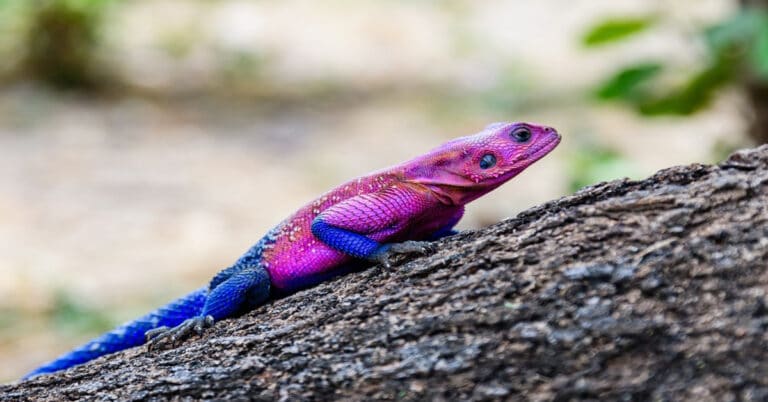Frilled Lizard
Scientific Classification
| Kingdom: | Animalia |
| Phylum: | Chordata |
| Class: | Sauropsida |
| Order: | Squamata |
| Suborder: | Lacertilia |
| Family: | Agamidae |
| Subfamily: | Agamidae |
| Genus: | Chlamydosaurus |
| Species: | C. kingii |
| Binomial Name: | Chlamydosaurus kingii |
We can call the frilled lizard Chlamydosaurus kingii any number of names including frill-necked lizard and frilled dragon. The frilled lizard is a large species of lizard that are arboreal in nature. It spends most of its lifetime up on the treetops.

Anatomy

The rather large folded skin, up against the frill necked lizard’s head and neck gives it the name Frilled Lizard. When it senses a threat, this folded skin fans out making the animal seem bigger and more threatening than it actually is. Frilled-neck lizard is basically a rather large species. An adolescent may grow one meter long. These lizards differ in color and size from region to region. On an average, the larger adults grow to about 3 feet or 0.9 meters in length from head to tail and weigh up to 1.1 pounds or 0.5 Kilos.

Behavior
Frill-necked is omnivorous as many other lizard species.. This means that the lizard will consume almost everything it finds. In spite of this, this lizard species will consume meat when and as as it preys on a variety of insects, spiders, rats or even small reptiles.
Habitat
Frill-necked lizards are native to the jungles of Australia and surrounding islands. You can find this fairly large species in humid climates like tropical jungles and forests, across the Australian continent and in Papua New Guinea. Frilled Lizard is certainly a strong icon in Australian culture and appears on their currency. It is also the mascot of many Australian teams and organizations.
As a Pet
Breeding
The frill-necked lizard species mate by the commencement of the rainy season. The males are always slightly bigger than the females. Female lizards lay as much as 25 eggs in burrows before covering them up . The lizard eggs hatch within months.
Housing

Frilled lizards are arboreal creatures. They spend the major portion of their life time in trees. When you want to create an enclosure for these lizards, you must consider height as a factor of vital importance. You can make use of artificial stones, vines , branches, cascades, misters as well as artificial and real plants for decoration. When you make use of real plants, you must consider edible plants and those that can potentially harm your pet.
Like most lizards the frilled dragon loves to bask. Exposure to UVB radiation is essential for it to synthesize vitamin D3 and for the proper metabolism of calcium. Commercially available fluorescent, compact fluorescent, and mercury vapor bulbs can provide this. Mercury vapor lamps have the added advantage of providing heat along with UVB. These lights also give out UVA radiation that many experts consider can help your pet see its prey better and also regulate its emotional health.
Food
Frilled Dragons are basically carnivorous. They eat a wide range of insects, spiders, and small vertebrates in the wild. Crickets, wax worms, mealworms and even frozen mice in captivity. To ensure maximum nutrition. You should arrange to provide insects along with a small amount of dark leafy greens.
Dust the insects that you feed with a calcium supplement many times a week as well as a multivitamin supplement once or twice a week.
You would do well to provide an open pan of water large enough for your lizard to soak as well as defecate. Misting the cage many times a day also creates ‘dew’ for your lizard to consume greedily.
Handling
Scoop up your dragon lizard from behind. Hold it gently but with a firm grip in your hands. Do not try to catch it by the tail or limbs.

Having discovered a fondness for insects while pursuing her degree in Biology, Randi Jones was quite bugged to know that people usually dismissed these little creatures as “creepy-crawlies”.







